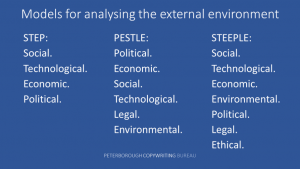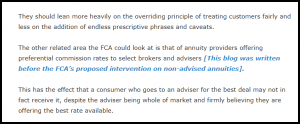Even the best content can soon become out of date – here are some tips for spotting and fixing problems.
A simple way to approach this part of the audit is to break the task down into considering the internal and external environments.
NOTE: This is part 1 in a ten-part serialisation of my eBook. Please read the introduction first if you are new to the tool.
Internal environment
Sometimes internal changes mean the content is no longer relevant to your organisation’s current strategy or activity.
I saw a classic example of this when a client launched a new product with a distinctive name and were in the middle of a PR campaign to promote it. Two years previously they had used the same name for a very early version of the product that hadn’t really taken off – and their website was littered with blogs and other pages using the product name.
When someone Googled the product name after seeing some publicity about it, they would likely be taken to a blog about the earlier version. This would have confused customers, potentially losing sales.
External environment
If you’ve studied marketing, you will remember the ‘STEP’ model for analysing the external environment. You can use it here, considering the Social, Technological, Economic and Political factors that may make your content look out of date. (Other versions of the model are PEST, STEEPLE or PESTLE, but they all do the same thing.)

You don’t need to do a full analysis like you would when creating a marketing plan. It’s just a matter of thinking about any external factors relevant to the piece of content you are assessing. A typical scenario would be where a piece of ‘thought leadership’ content becomes out of date after changes in the economic situation.
Imagine if you are a financial adviser and you have a major piece of content from 2008 discussing mortgage options. The housing market has changed since then, as have interest rates and rules around mortgage availability. Your content could therefore be hopelessly out of date. This is the type of thing you are on the lookout for at this opening stage of the audit.
Some solutions to ‘context’ problems
Now let’s look at some options for addressing any problems that become evident when you look at the context of your piece of content.
Option 1: edit the content to bring it up to date
This is usually the best option: best for readers and best for continuing any SEO performance your content has achieved. Often this isn’t a major task and a little editing here and there can fix the problems. Just make sure that any keyword phrases the content originally featured remain in place to maintain SEO performance.
Once the content has been edited, it could be wise to add a note at the top of the page to inform visitors that there has been an update.
Option 2: link to more relevant content
If you have published more up-to-date content since the piece you are auditing was created, simply link to the new content near the top of the out-of-date content, as in this example:
‘Since we published this guide to mortgages in 2008 the market has changed considerably.
Please visit our latest guide to finding the right mortgage for up-to-date information.’
Option 3: add some explanation
A quicker (although less satisfactory) fix is to add a sentence or two somewhere near the top of the content to acknowledge that it’s no longer relevant. Something like this:
‘Please note: since we published this guide to mortgages in 2008 the market has changed considerably. Always seek professional advice to ensure that you are making decisions based on the latest market conditions.’
Here’s an example of this approach as applied by Retirement Planner:

Online musical instrument retailer Sweetwater does it when a product is no longer available. They leave the content for a discontinued product in place on their website, but add an explanation and an invitation to look at alternatives.

But be careful if your page has attracted valuable back links to it. If the content becomes out of date, it’s possible that the sites linking to your content will gradually turn off their links.
Option 4: delete it
Alternatively, you can of course just delete the content altogether. This is far from ideal, but it may be acceptable if it’s a page that isn’t performing well from an SEO perspective, and if you are sure that there aren’t many links to the page from within your own site or external sources.
Where possible, set up a 301 redirect to another page that covers the same subject with more current information. This will hopefully pass most of the old page’s SEO ranking power to the new page.

